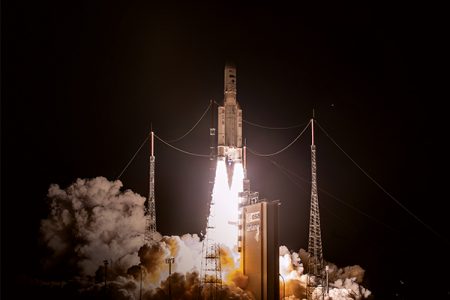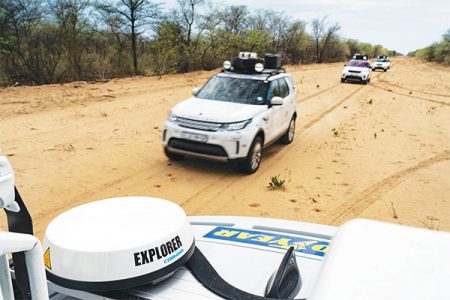
While Covid-19 continues in full swing, satellite operator Inmarsat is busy making its fifth GX satellite operational while simultaneously prepping for the launch of two of its sixth-generation (I-6) satellites. Inmarsat claims to be the first commercial operator in the world to feature Ka-band payloads hosted on L-band satellites.
In parallel, the satellite operator, which has made significant inroads into the Middle East in recent years by delivering additional focussed capacity across Europe and the Middle East through its Global Xpress fleet, is now looking to further strengthen its position in the region with the new launches.
The two I-6 satellites are being constructed by Airbus Defence and Space and are scheduled to enter commercial service in 2022, with the first due for a 2021 launch. They will carry payloads for GX6A and B on the ultra-high-speed Ka-band as well as on L-band, providing crucial extra capacity for the kind of safety systems required as growth and digitalisation continue to accelerate across the region. The I-6 fleet will also support a new generation of capabilities for the 5G era as well as global safety services, long into the 2030s and beyond.
GX5 and the two GX payloads on the I-6 satellites are part of what Inmarsat calls its “Technology Roadmap” strategy. This programme will see an additional five GX satellites launched within the next three years. It will deliver further capacity in MENA as well as across the world, including two GX satellites dedicated to the Arctic region.
With these launches, Inmarsat will also help to significantly boost the massive digital disruption that is taking place in the Middle East, as we speak.

“The Middle East is heading rapidly towards a digital economy,” says Carl Statham, Vice President of Inmarsat Enterprise. “Of course, every region across the world wants to accelerate digitalisation. But an economy based on smart, efficient use of data can create wealth, improve public health, generate jobs and modernise industries. Today, evidence from several nations in the Middle East – and several sectors of industry – suggests that even with the recent challenges posed by Covid-19, the region really is starting to build momentum as a digital powerhouse for the next decade and beyond.”
Statham goes on to add that “strong connectivity – especially in remote or complex industries and communities that require consistent, reliable access to data – will be key to ensuring this potential is realised”.
This is where satellite-based connectivity comes in. Sometimes overlooked amid the talk of ultra-fast broadband, fibre optic connections and Giga speeds, the ability of “satcoms” to provide secure, consistent connections in places that cables just cannot reach is going to prove vital to realising the Middle East’s digital ambitions, he points out.
This need for satcoms is why Inmarsat, a major player in this sector, has continued to increase its focus and resources available to companies and governments in the Middle East in recent years.
The company’s fifth Global Xpress satellite (GX5) was specially designed to increase the availability of satellite-based mobile broadband over the Middle East. Based on a clear surge in demand for this kind of connectivity in recent years, GX5 will deliver double the capacity of Inmarsat’s entire existing GX fleet (GX1-GX4) and will help enable the Middle East’s digital transformation.
Longstanding industries are one of the key beneficiaries of satellite-based connectivity.
Oil and gas extraction, for example, has benefitted from satcoms data for several years already. Statham explains: “When drilling equipment fails on an oil well hundreds of kilometres out in the desert, the cost of repair becomes critical. The combination of raw materials required to fix it, the labour needed and time taken to transport the materials out to the site quickly add up. In addition, every hour the well is out of action is an hour’s worth of oil or gas lost from production targets.
“Because of their remote location, traditional ground-based connectivity may not be an efficient, reliable option for these wells. So instead, many have turned to Inmarsat and its satellite-based data.”
Today, drilling equipment is monitored constantly to identify excess weights, load or torque that could lead to critical failure of the well. That data, transmitted through an Inmarsat broadband global area network (BGAN) terminal, is closely monitored remotely, ensuring a safe, well-operating well that will not shut down from equipment failure.
Another traditional industry that has increasingly been powered by satellite-based connectivity is shipping, which alone contributes to 12% of Dubai’s gross domestic product, according to global law firm, Ince & Co.

Eric Griffin, Vice President of Inmarsat Maritime points out that seafarers have relied on satcoms to provide SOS and distress signal services for over 40 years.
“This was Inmarsat’s founding mission, but new technology is enabling this role to expand to the digitalisation of vessels and the growth of applications. One such example is the increasing trend towards remote survey inspections. These are vital to ensure vessels continue to meet international safety standards, and it is satellite-based connectivity that helps make this possible,” he says.
With supply chains stretched and many seafarers being asked to take on extraordinary duties during the Covid-19 pandemic, crew welfare has become another important consideration in 2020, Griffin points out.
“Weeks or even months at sea without family made satellite phone calls and video links even more important to mental health onboard,” he explains.
Perhaps one growing trend that has been observed in the region is vessel owners using connectivity to not only save money from operating efficiencies but to open up new revenue opportunities.
“Satcoms again serves a critical role here to create the infrastructure necessary for the adoption of more effective digital technologies,” Griffin explains.
Another key market that has benefitted significantly from satcoms is the aviation market.
“While flying numbers declined at the height of the pandemic, as passengers return, they will find in-flight Wi-Fi becoming more and more common on the journeys they take,” Statham says.
In the meantime, we see consumers also becoming keen advocates of satellite connectivity just as much as businesses and governments.
Statham cites a recent agreement concluded alongside Globalbeam Telecom and Virgin Megastores in the United Arab Emirates recently.

“This agreement will see Inmarsat’s satellite phones (the IsatPhone 2) and portable Wi-Fi terminals (the Inmarsat BGAN product) become available on sale to the general public,” explains Statham.
“The IsatPhone 2 is now available in Virgin Megastores across the UAE and we are seeing a lot of interest in the product. It is an incredibly robust, reliable phone and perfect for travellers moving through remote places, adventurers driving through desert regions or simply as a backup for peace of mind.”
These same BGAN terminals are becoming an increasingly common sight on big infrastructure projects as well.
“Construction companies can now routinely track and ensure the safety of their crews on the growing number of high-speed road and rail connections being built to connect cities across the Middle East. And once they are built, Inmarsat satellite connectivity is helping trains run at optimal efficiency, arriving safely on time after journeying hundreds of miles across the desert,” explains Statham.
An interesting but not often recognised use of satellite connectivity is also how it helps the traditional pastime of falconry in providing reliable connectivity deep in the wilderness for those venturing out with their birds of prey.
In an historic recent development, Inmarsat, through its partner Sada Alammah and subsidiary Globalbeam Telecom, was also granted market access to Saudi Arabia to provide satellite services to government, business and consumers. Inmarsat’s entry into the Kingdom will help make a significant contribution to the nation’s 2030 digital vision by providing highly reliable mobile connectivity to assets on land, at sea and in the air. Already, several Saudi Arabian shipping and offshore companies have started using Inmarsat services, with more set to follow.
This range of use cases – covering traditional industries, new infrastructure projects, consumer demand and traditional pastimes – highlights the speed at which governments and businesses in the Middle East are moving towards a connected, digital way of living.
“Inmarsat continues to build on its space-based infrastructure and even during a period of economic turbulence, we have continued to announce new launches. Besides the I-6 fleet, additional launches are planned between 2022 and 2024 that will also include new satellites over the Arctic region,” says Statham.
No doubt, connectivity will become even more critical and power the Middle East’s development well into the 2030s. Making sure that every industry and every government can benefit – no matter how remote, complex or challenging its operating conditions – will rely increasingly on the power of satellites to connect people and the data they rely on.














Add Comment